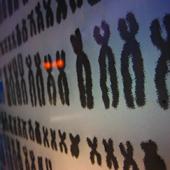PRINCIPLE OF THE TEST METHOD:
Cell cultures are exposed to the test substance both with and without metabolic activation. At predetermined intervals after exposure of cell cultures to the test substance, they are treated with a metaphase-arresting substance (e.g. Colcemid® or colchicine), harvested, stained and metaphase cells are analysed microscopically for the presence of chromosome aberrations.
TEST CONDITIONS:
Solvent/vehicle: The solvent/vehicle should not be suspected of chemical reaction with the test substance and should be compatible with the survival of the cells and the S9 activity. If other than well-known solvent/vehicles are used, their inclusion should be supported by data indicating their compatibility.It is recommended that wherever possible, the use of an aqueous solvent/vehicle be considered first. When testing water-unstable substances, the organic solvents used should be free of water. Water can be removed by adding a molecular sieve.
Exposure concentrations: Among the criteria to be considered when determining the highest concentration are cytotoxicity, solubility in the test system, and changes in pH or osmolality. Cytotoxicity should be determined with and without metabolic activation in the main experiment using an appropriate indication of cell integrity and growth, such as degree of confluency, viable cell counts, or mitotic index. It may be useful to determine cytotoxicity and solubility in apreliminary experiment. At least three analysable concentrations should be used. Where cytotoxicity occurs, these concentrations should cover a range from the maximum to little or no toxicity; this will usually mean that the concentrations should be separated by no more than a factor between 2 and 10. At the time of harvesting, the highest concentration should show a significant reduction in degree of confluency, cell count or mitotic index, (all greater than 50%). The mitotic index is only an indirect measure of cytotoxic/cytostatic effects and depends on the time after treatment. However, the mitotic index is acceptable for suspension cultures in which other toxicity measurements may be cumbersome and impractical. Information on cell cycle kinetics, such as average generation time (AGT), could beused as supplementary information. AGT, however, is an overall average that does not always reveal the existence of delayed subpopulations, and even slight increases in average generation time can be associated with very substantial delay in the time of optimal yield of aberrations. For relatively noncytotoxiccompounds the maximum concentration should be 5 ml/ml, 5 mg/ml, or 0.01M, which ever is the lowest. For relatively insoluble substances that are not toxic at concentrations lower than the insoluble concentration, the highest dose used should be a concentration above the limit of solubilityin the final culture medium at the end of the treatment period. In some cases (e.g. when toxicityoccurs only at higher than the lowest insoluble concentration) it is advisable to test at more than oneconcentration with visible precipitation. It may be useful to assess solubility at the beginning and the end of the treatment, as solubility can change during the course of exposure in the test system due topresence of cells, S9, serum etc. Insolubility can be detected by using the unaided eye. The precipitate should not interfere with the scoring.
Controls: Concurrent positive and negative (solvent or vehicle) controls both with and without metabolic activation should be included in each experiment. When metabolic activation is used, the positive control chemical should be the one that requires activation to give a mutagenic response. Positive controls should employ a known clastogen at exposure levels expected to give areproducible and detectable increase over background which demonstrates the sensitivity of the testsystem. Positive control concentrations should be chosen so that the effects are clear but do not immediately reveal the identity of the coded slides to the reader.
PROCEDURE: Proliferating cells are treated with the test substance in the presence and absence of a metabolic activation system. Treatment of lymphocytes should commence at about 48 hours after mitogenic stimulation. Duplicate cultures should normally be used at each concentration, and are stronglyr ecommended for negative/solvent control cultures. Where minimal variation between duplicatecultures can be demonstrated, from historical data, it may be acceptable for single cultures to be used at each concentration. Gaseous or volatile substances should be tested by appropriate methods, such as in sealed culture vessels .
Culture harvest time: In the first experiment, cells should be exposed to the test substance both with and activation for 3-6 hours, and sampled at a time equivalent to about 1.5 normal cell cycle length after the beginning of treatment. If this protocol gives negative results both with and without activation, an additional experiment without activation should be done with continuous treatment until sampling at a time equivalent to about 1.5 normal cell cycle lengths. Certain chemicals may be more readily detected by treatment/sampling times longer than 1.5 cycle lengths. Negative results with metabolic activation need to be confirmed on a case-by-case basis.
DATA AND REPORTING: The experimental unit is the cell, and therefore the percentage of cells with structuralchromosome aberration(s) should be evaluated. Different types of structural chromosome aberrationsshould be listed with their numbers and frequencies for experimental and control cultures.
